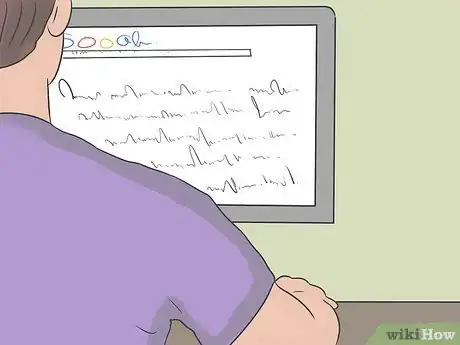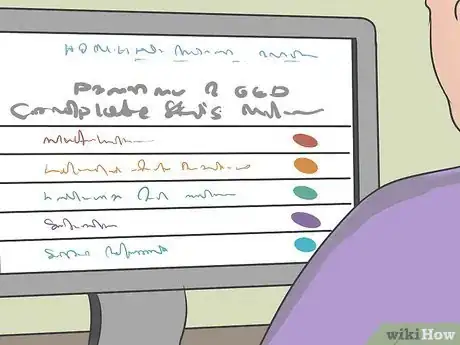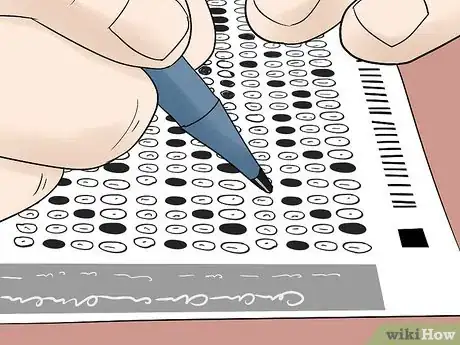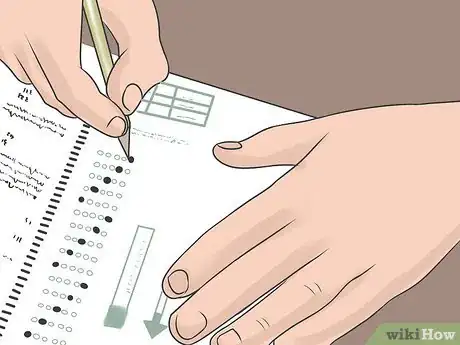This article was co-authored by Alexander Ruiz, M.Ed.. Alexander Ruiz is an Educational Consultant and the Educational Director of Link Educational Institute, a tutoring business based in Claremont, California that provides customizable educational plans, subject and test prep tutoring, and college application consulting. With over a decade and a half of experience in the education industry, Alexander coaches students to increase their self-awareness and emotional intelligence while achieving skills and the goal of achieving skills and higher education. He holds a BA in Psychology from Florida International University and an MA in Education from Georgia Southern University.
wikiHow marks an article as reader-approved once it receives enough positive feedback. In this case, 83% of readers who voted found the article helpful, earning it our reader-approved status.
This article has been viewed 25,323 times.
General Education Development (GED) tests are designed to certify that a person who passes the test has achieved a level of academic proficiency equal to that provided by high school education. Typically, GEDs are taken by people who have not finished high school and who wish to obtain an equivalent credential. See Step 1 below to start learning how to pass your upcoming GED.
Steps
Learning GED Material
-
1Know the subjects covered by the GED. The GED test contains five different sections, each devoted to its own subject. Each section contains 40-50 multiple choice questions, with the exception of the math section, which also contains "constructed answer" questions (in which you must specify the exact answer rather than fill in a bubble) and the writing section, which contains an additional essay. The five sections of the GED are:
- Social Studies
- Science
- Reading
- Mathematics
- Writing
-
2Know the material covered by the Social Studies section. The Social Studies section of the GED is 70 minutes long and contains 50 multiple-choice questions. The Social Studies section tests the student's knowledge of history, economics, civics, and geography. Note that this section has two versions, a U.S. and Canadian version, both with civics and history questions specific to each respective nation. The multiple-choice questions are distributed between these areas as follows:
- History (U.S. or Canada, 25%, World, 15%)
- Geography (15%)
- Civics and government (25%)
- Economics (20%)
Advertisement -
3Know the material covered by the Science section. The Science section of the GED is 80 minutes long and contains 50 multiple-choice questions. The section tests the student's knowledge of life science, physical science, and earth and space science. The questions in the section are distributed between these areas as follows:
- Life science (biology, medicine, etc., 45%)
- Physical science (physics and chemistry, 35%)
- Earth and space science (astronomy, etc., 20%)
-
4Know the material covered by the Reading section. The Reading section of the GED is 65 minutes long and contains 40 multiple-choice questions. The section tests the student's ability to comprehend and analyze written passages. The section draws questions from two categories, fiction and nonfiction. The questions are distributed between these areas as follows:
- Fiction (passages taken from at least one of the following: poetry, drama, prose fiction before 1920, prose fiction between 1920 and 1960, and prose fiction after 1960, 75%)
- Nonfiction (passages taken from any two of the following: nonfiction prose, visual and performing arts reviews, workplace and community documents, 25%)
-
5Know the material covered by the Mathematics section. The mathematics section contains two 45-minute parts and contains 50 questions in total. 80% of the questions are multiple-choice, while 20% are "constructed answer" questions in which the test taker may have to write the answer in a blank, fill in points on a graph, and so on. All questions in this section are distributed between the following areas:[1]
- Number operations and number sense (20-30%)
- Measurement and geometry (20-30%)
- Data analysis, statistics, and probability (20-30%)
- Algebra, functions, and patterns (20-30%)
-
6Know the material covered by Part I of the Writing section. The writing section contains two parts - one multiple-choice part and one essay part. The first part is 75 minutes long and contains 50 multiple-choice questions. This part tests the student's ability to correct practical, real-world documents for grammar, spelling, and mechanical errors. The questions in this part are distributed between the following areas:
- Organization (15%)
- Sentence structure (30%)
- Usage (30%)
- Mechanics (25%)
-
7Know the material covered by Part II of the Writing section. The second part of the writing section is 45 minutes long and requires you to plan, organize, and write an essay on a provided topic. The topic of the essay is not disclosed beforehand. The essay doesn't have a goal in terms of word count - rather, the essay is graded based on its content. Two readers grade the essay based on the following criteria:
- Focused main points
- Clear organization
- Specific development of ideas
- Sentence structure control, punctuation, grammar, word choice, and spelling
Studying for the GED
-
1Schedule a test date that gives you plenty of time to study. Even if you're confident that you'll be able to pass the GED, it's still wise to study, especially if you haven't been to school for a while. When you schedule a test, be sure that you choose a date that will allow you adequately prepare, taking into account any family or work responsibilities that may compete for your time.
- Tests can be scheduled electronically from the official GED website.[2]
-
2Prioritize your weak areas. Use your study time wisely! Since you know (roughly) which subjects you'll be tested on, try to devote the most time and effort to reviewing ones that you know have unsteady foundations. For instance, if you're decent at math, but you have almost no knowledge of world history, you would do well to spend most of your time brushing up on basic historical concepts while only lightly reviewing your math skills. That said, make sure you also spend some time updating and renewing your knowledge of your strong subjects.
-
3Be persistent, rather than sporadic. A moderate, consistent study routine is almost always better than a spotty, hectic one. Rather than "cramming" at the last minute or "binge-studying" once or twice for hours on end in the days leading up to the test, instead, spread your burden out over the months or weeks leading up to your test. Studying consistently over a long period of time has been shown to aid in information retention much better than spending the equivalent amount of study time in a last-minute sprint to prepare.[3]
- One additional consideration is that cramming can interfere with your sleep schedule the night before the test. Showing up fatigued to your GED can markedly decrease your performance.
- Following a consistent study schedule will help you remember the material better, since you're spending more time and dedicating more effort to it. Being mindful about how you're using your schedule usually creates stronger results.
-
4Use sample test resources. While there are no hard and fast rules about which study practices are and aren't appropriate, most people can benefit substantially by seeking out and reviewing questions that resemble those found on the actual GED test. A few select sample questions are listed on the official GED website, as is a free practice test.[4]
- Additionally, if you're willing to spend money, a wide variety of paid GED test resources are available both online and in commercial and academic bookstores.
Taking the GED
-
1Ensure you're well-rested and fed. On test day, you want to eliminate as many distractions as possible so that you're able to devote your entire concentration to the GED test. Two big distractions that are often forgotten by students are hunger and fatigue. The effect that biological factors like these can have on a test taker's score are real, tangible, and pronounced.[5] Be sure to get a full night's rest the night before your test and to eat a healthy breakfast the following morning to ensure you're not kept from reaching your full potential by hunger pangs or heavy eyelids.
-
2Pay attention to the time limit. As noted above, each section of the GED has a specified time limit. Unless you're able to secure an official disability accommodation (for which you can apply at the GED website[6] ), these time limits are inflexible. Generally, each section allows between 1 and 2 minutes per problem - this information can help you budget your time wisely. However, the essay section has a single 45-minute time limit during which you must synthesize an entire essay. Be aware of the time limit as you work - you can't correctly answer any questions you don't get to.
- To "get used" to the feeling of working under a time limit, you may want to try incorporating timed practice into your study routine. Use a stopwatch or timer to keep track of the time you're taking as you complete practice problems.
-
3Answer problems you know first. Because of the aforementioned time limit, it's important to budget the time you spend on each question wisely. One tried and true test-taking strategy is to skip questions that you don't immediately know how to answer. In other words, only answer the questions you know how to answer right away - don't spend time trying to figure out difficult questions. Then, when you reach the end of the section, go back and attempt to answer the difficult questions. This strategy ensures you use your time as efficiently as possible, answering as many easy, "sure thing" questions as you can.
- When you skip questions, be sure to skip the corresponding lines in your multiple choice answer sheet to avoid a disastrous mis-match of the rest of your answers in the section.
- Make sure you read all the test instructions thoroughly before starting, even if you notice you already know the answer to some questions just by glancing at them.
-
4Strive for clarity in your essay. Above all, try to make your essay as clear, straightforward, and coherent as possible. This applies primarily to the quality of your argument, but also to the actual presentation of your essay with regards to handwriting, proper paragraph structure, spelling, and so on. The essay is the only part of the GED graded by actual humans - as such, it's the only part of the essay where it's important to remember that your work should communicate an idea to another person as clearly and strongly as possible.
-
5Use extra time to review. With all likelihood, you may finish one or more sections of the GED with time to spare. Make the most of this extra time - spend it going over your work, especially any that posed challenges to you. Any extra points you can gain from revising incorrect answers can add up to a big overall score boost.
- This advice is extra-important for the essay section. Extra time spent on the essay can allow you to enhance your argument, add extra examples, make your thesis more clear, and much more.
Expert Q&A
-
QuestionWhat can you accomplish with a GED?
 Alexander Ruiz, M.Ed.Alexander Ruiz is an Educational Consultant and the Educational Director of Link Educational Institute, a tutoring business based in Claremont, California that provides customizable educational plans, subject and test prep tutoring, and college application consulting. With over a decade and a half of experience in the education industry, Alexander coaches students to increase their self-awareness and emotional intelligence while achieving skills and the goal of achieving skills and higher education. He holds a BA in Psychology from Florida International University and an MA in Education from Georgia Southern University.
Alexander Ruiz, M.Ed.Alexander Ruiz is an Educational Consultant and the Educational Director of Link Educational Institute, a tutoring business based in Claremont, California that provides customizable educational plans, subject and test prep tutoring, and college application consulting. With over a decade and a half of experience in the education industry, Alexander coaches students to increase their self-awareness and emotional intelligence while achieving skills and the goal of achieving skills and higher education. He holds a BA in Psychology from Florida International University and an MA in Education from Georgia Southern University.
Educational Consultant A GED allows you to look for new employment and/or new opportunities in higher education (or even secondary schools). In other words, your GED can help you advance your career or your education.
A GED allows you to look for new employment and/or new opportunities in higher education (or even secondary schools). In other words, your GED can help you advance your career or your education. -
QuestionWhere can I find study materials for the GED exam?
 LeahlovesGodTop AnswererThere are many websites to choose from. You can purchase "The Complete Canadian GED Preparation Handbook," which, although it is for Canadians, covers all the other topics.
LeahlovesGodTop AnswererThere are many websites to choose from. You can purchase "The Complete Canadian GED Preparation Handbook," which, although it is for Canadians, covers all the other topics. -
QuestionWhat resources should I use to study?
 Community AnswerFlashcards, highlighter, and post-its are all useful in reviewing the material. You can put the internet to good use for researching the topic you are studying. Study groups can also be helpful and motivating.
Community AnswerFlashcards, highlighter, and post-its are all useful in reviewing the material. You can put the internet to good use for researching the topic you are studying. Study groups can also be helpful and motivating.
References
- ↑ http://www.gedtestingservice.com/testers/math
- ↑ http://www.ged.com/
- ↑ https://www.uclahealth.org/news/cramming-for-a-test-dont-do-it-say-ucla-researchers
- ↑ http://www.gedtestingservice.com/educators/freepracticetest
- ↑ http://www.medicalnewstoday.com/releases/93257.php
- ↑ http://www.gedtestingservice.com/testers/accommodations-for-disability














































































